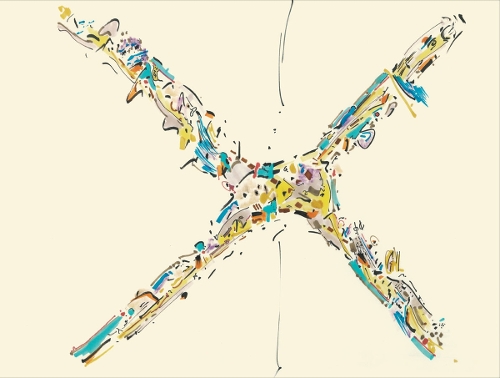
Gordon Matta-Clark: The Beginning of Trees and the End
(Hardback)
Publishing Details
Gordon Matta-Clark: The Beginning of Trees and the End
David Zwirner
David Zwirner
1st August 2016
United States
Classifications
General
Non Fiction
Individual artists, art monographs
Drawing and drawings
741.973
Physical Properties
Hardback
184
Width 305mm, Height 230mm
1340g
Description
Well known for his radical "anarchitectural" interventions throughout the 1970s, Gordon Matta-Clark was always deeply, though less publicly, committed to drawing. His works on paper - which span three- dimensional reliefs, calligraphy, and notebook entries - capture the interdisciplinary spirit that defined the art world in the 1970s. Intricate and concise, they testify to his interest in the crossovers between visual and performance arts, as well as the broader integration within his oeuvre of the natural and built environment. The Beginning of Trees and the End, published on the occasion of Matta-Clark's eponymous 2015 show at David Zwirner, documents the artist's extraordinary accomplishments as a draftsman. Organized by theme, the catalogue presents in vibrant detail selections from Matta-Clark's Cut Drawings, Energy Rooms, Energy Trees, and his own "calligraphy," many of which have never been published. Perhaps the best known of the group, the Cut Drawings explore parallel, smaller-format versions of his physical interventions in architecture; slicing meticulously through several layers of paper, gesso, or cardboard, Matta-Clark created sculptural flat works that emphasized the voids created by the extraction of matter. Some of the most elaborate and colorful compositions include trees. In full-color plates, the reader can see the physical structure of his trees "dissolving" into kinetic energy and, in some drawings, becoming reduced to a multitude of arrows. Matta-Clark's notebooks, which he often insisted on completing in a single sitting, are presented in elegantly curated groups. Combining elements of Surrealist automatic drawing with an interest in choreography, these works appealed to performance artists at the time-including Laurie Anderson and Trisha Brown. This unparalleled presentation of Matta-Clark's drawings is accompanied by new and exciting scholarship by Briony Fer, as well as a conversation between Jessamyn Fiore and contemporary artist Sarah Sze; it marks a major contribution to the literature on this highly influential artist.
Reviews
"Expansive, yet focused exhibition... Making the selection particularly distinctive is its focus on the artist's works on paper, a medium that contrasts with the New York native's experiments with cement or other industrial materials."--O.C. Yerebakan "Art Observed"
"Matta-Clark brutally manipulates whole buildings by physically altering them as a performance and as a transitory sculpture. The kinetic energy found in these site specific works is brought to life in the drawings he has left behind."--Jamie Ho "Need Supply Co."
"Matta-Clark was as accomplished at making drawings with pencils, pens, markers, and crayons as he was at cutting into abandoned warehouses, suburban homes, and dilapidated tenement buildings with a chain saw. And these drawings offer a variety of insights into the artist's attitudes about nature, movement, and geometry..."--Phyllis Tuchman "ARTFORUM"
Matta-Clark's "calligraphy" and drafts "have magical powers that are almost stronger when you can't read them, and a sense that unreadable scripts return us to an era that's less pedestrian than our own."--Blake Gopnik "Artnet News"
Author Bio
Born in New York in 1943, Gordon Matta-Clark is widely considered one of the most influential artists working in the 1970s. He was a key contributor to the activity and growth of the New York art world in SoHo from the late 1960s until his untimely death in 1978. His practice introduced new and radical modes of physically exploring and subverting urban architecture, and some of his most well-known projects involved laboriously cutting holes into floors of abandoned buildings or, as with Splitting (1974), slicing a suburban villa in two.
Briony Fer is an art historian who has written extensively on modern and contemporary art. Her research interests have consistently moved between the history of the avant-gardes and the work of contemporary artists, including Gabriel Orozco, Roni Horn, David Batchelor, and Tacita Dean. Her books include On Abstract Art (1997), The Infinite Line (2004), and Eva Hesse: Studiowork (2009). She has also organized exhibitions of Eva Hesse's studiowork as well as, most recently, an exhibition of the work of Gabriel Orozco, accompanied by a monograph Gabriel Orozco: thinking in circles (2013). In spring 2014, she was Kirk Varnedoe Professor at the Institute of Fine Arts in New York. She is Professor of History of Art at University College London and a Fellow of the British Academy.
Jessamyn Fiore is a New York-based curator and writer as well as the co-director of the Estate of Gordon Matta-Clark. She is the curator of the Jean-Paul Najar Foundation opening in Dubai in November 2015. She received an MA in contemporary art theory, practice, and philosophy from The National College of Art and Design, Dublin in 2009. Exhibitions curated include 112 Greene Street: The Early Years (1970-1974), David Zwirner, New York (2011), which led to her editing the exhibition catalogue; Gordon Matta-Clark: Above and Below, David Zwirner, New York (2013); and II Machines: Clive Murphy & Trevor Tweeton, Knockdown Center, Queens (2015). Her original one-act play, Blast from The Past, based on the writings of Robert Smithson and Matta-Clark, was published in 2014.
Artist Sarah Sze lives and works in New York. She has a BA from Yale University, 1991 and an MFA from the School of Visual Arts, New York, 1997. In 2013, Sze represented the United States at the 55th Venice Biennale. She has had major solo exhibitions at the Fabric Workshop and Museum, Philadelphia; MUDAM, Luxembourg; Asia Society, New York; Malmo Konsthall, Sweden; Whitney Museum of American Art, New York; Museum of Contemporary Art Chicago; and the Institute of Contemporary Arts, London. Sze is a 2003 John and Catherine T. MacArthur Fellow.
